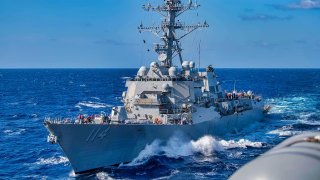The U.S. Navy is Firing Missiles in the Middle East Faster Than They Can be Replaced
The concern is the rate at which SM-3 missiles and other ordnances, including the SM-2 and SM-6, are now being fired. The U.S. is now depleting its stockpiles faster than the missiles can be replaced, and that has raised alarms.
On October 1, USNI News reported that the Arleigh Burke-class destroyers USS Bulkely (DDG-84) and USS Cole (DDG-67) "fired a dozen interceptors as part of the U.S. response to Iranian missiles launched at Israel." The United States Department of Defense confirmed the warships were successful in countering the Iranian attack. Both destroyers employ the Aegis air-defense system that was designed specifically to counter ballistic missiles.

The Islamic Republic fired more than 200 missiles at Iran in response to Israel's ground invasion of Lebanon, but over the past year, U.S. warships have also countered hundreds of missiles and drones fired at Israel and commercial shipping in the Red Sea by the Tehran-back Houthi rebels based in Yemen. More than a half dozen U.S. Navy guided-missile destroyers are now independently deployed in the region as part of the "multi-national response to the Houthi attacks on commercial shipping," USNI News confirmed.
Though no U.S. Navy warship has taken damage from the attacks – although there have been claims to the contrary – the war is proving to be a costly one, literally. Business Insider reported on Friday that in the most recent Iranian strikes at Israel, the U.S. guided-missile destroyers fired the Standard Missile-3, "a key air-defense interceptor made by RTX and, for some variants, Mitsubishi Heavy Industries."
BI added that the ordnance "was first used in combat in April to shield Israel from an unprecedented attack, and then it saw combat again in October when Iran attacked a second time." Though a price can't be put on human life, and the U.S. Navy did the right thing in defending Israel, it should be noted that each missile has a price tag of at least $10 million, while some variants can cost upwards of $30 million.
It could – and likely should – be argued that while the SM-3 had been thoroughly tested, its capabilities were really only truly put to the test in April. Until then it was still an unproven platform. We could consider the missions in April and October to be pricey final tests.
Yet, beyond the price, the concern is the rate that the SM-3 missiles and other ordnance including the SM-2 and SM-6 are now being fired. The U.S. is now depleting its stockpiles faster than the missiles can be replaced, and that has raised alarms.
"We are far below rates of production to support a high-end conflict," Bryan McGrath, a retired naval officer and the managing director of The FerryBridge Group LLC, told BI.
The greatest concern is that the United States military, which had sought to refocus on great power competition and move away from the endless Global War on Terror (GWoT), is being drawn back into the Middle East. It could leave it unprepared for a conflict with a near-peer adversary, notably China.
In April, after the SM-3 had its baptism of fire, Secretary of Navy Carlos Del Toro urged lawmakers that more SM-3 missiles would be needed.
"I truly believe that the SM-3s will be needed in greater numbers in the future, given the operations that took place in defense of Israel," Del Toro said "Recently, some were fired. And very effectively. So I think given the future threat and our deterrence mission of the Indo-Pacific, we are going to need more SM-3s in the future."
The U.S. is now only producing a few dozen – at most – annually. As has been seen in the recent operations, a year's worth could be used up in just a few days.
The U.S. Navy – and the other branches of the military – are continuing to explore less expensive options, including lasers to counter the threat from drones and missiles. However, the SM-3 is highly effective, and it is clear that the U.S. military will need as many as it can get in a war with China or another near-peer adversary.
Author Experience and Expertise: Peter Suciu
Peter Suciu is a Michigan-based writer. He has contributed to more than four dozen magazines, newspapers, and websites with over 3,200 published pieces over a twenty-year career in journalism. He regularly writes about military hardware, firearms history, cybersecurity, politics, and international affairs. Peter is also a Contributing Writer for Forbes and Clearance Jobs. You can follow him on Twitter: @PeterSuciu. You can email the author: [email protected].
Image Credit: Creative Commons and/or Shutterstock.


